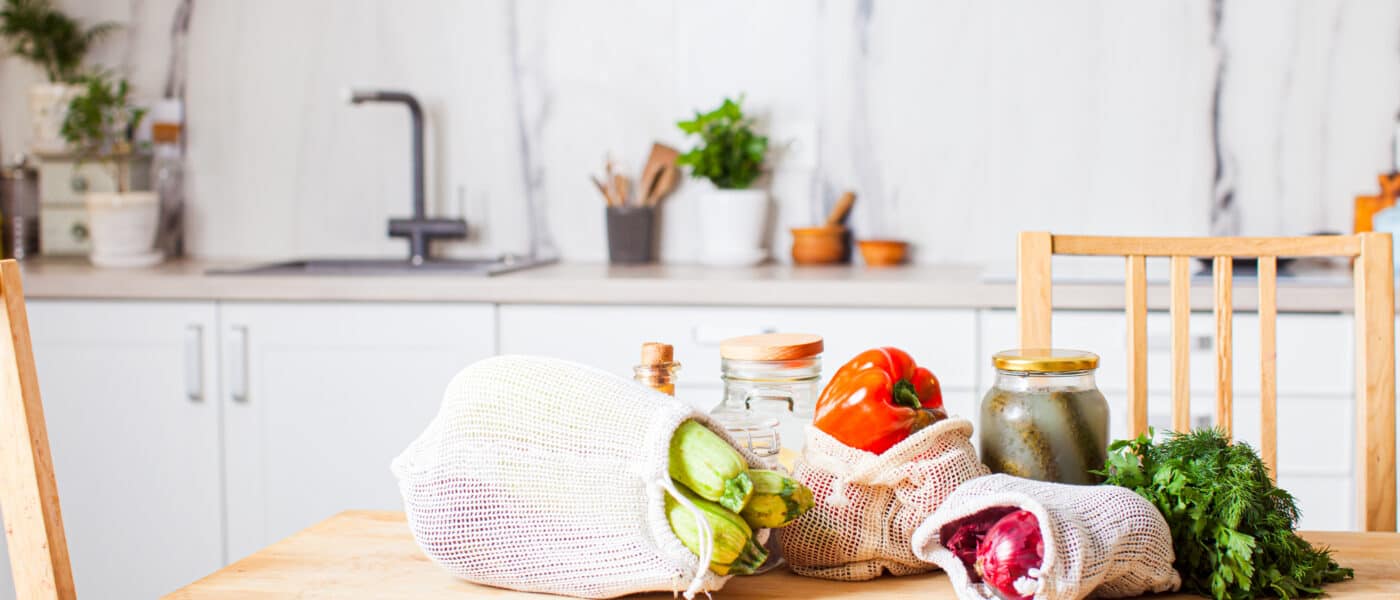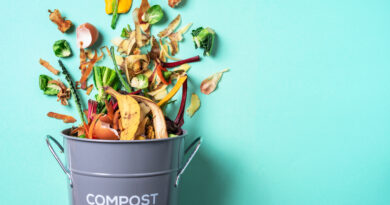Want to reduce plastic in the kitchen? 5 Eco-friendly tips and swaps
Would you like to discover some new ways to minimize disposable plastics in your home? This post explores some easy and effective eco-friendly tips and swaps to help you reduce plastic and transform your kitchen into a more eco-friendly living space.
Kitchens are often one of the main hiding places for single-use plastic
In many homes, the kitchen is often one of the main hiding places for single-use plastic. Whether it’s food packaging, grocery bags, or disposable food wrap, most plastic items will end up in the garbage after just one short use. All this wasted plastic contributes to pollution, uses up our planet’s resources, and takes up a lot of landfill space. Not to mention, much of it also ends up in the environment as litter!
Ways to reduce plastic waste in the kitchen
Consciously changing habits—including what we buy—to reduce our environmental impact can take some effort, especially when we’ve been used to certain routines for a long time. But transitioning to a more Earth-friendly lifestyle doesn’t have to be hard or stressful. By consciously making a few simple changes, we can significantly reduce the amount of plastic we use and throw away.
Read on for some helpful tips to help you start shrinking your plastic footprint today!
1. Try to minimize the amount of plastic you bring home from the store
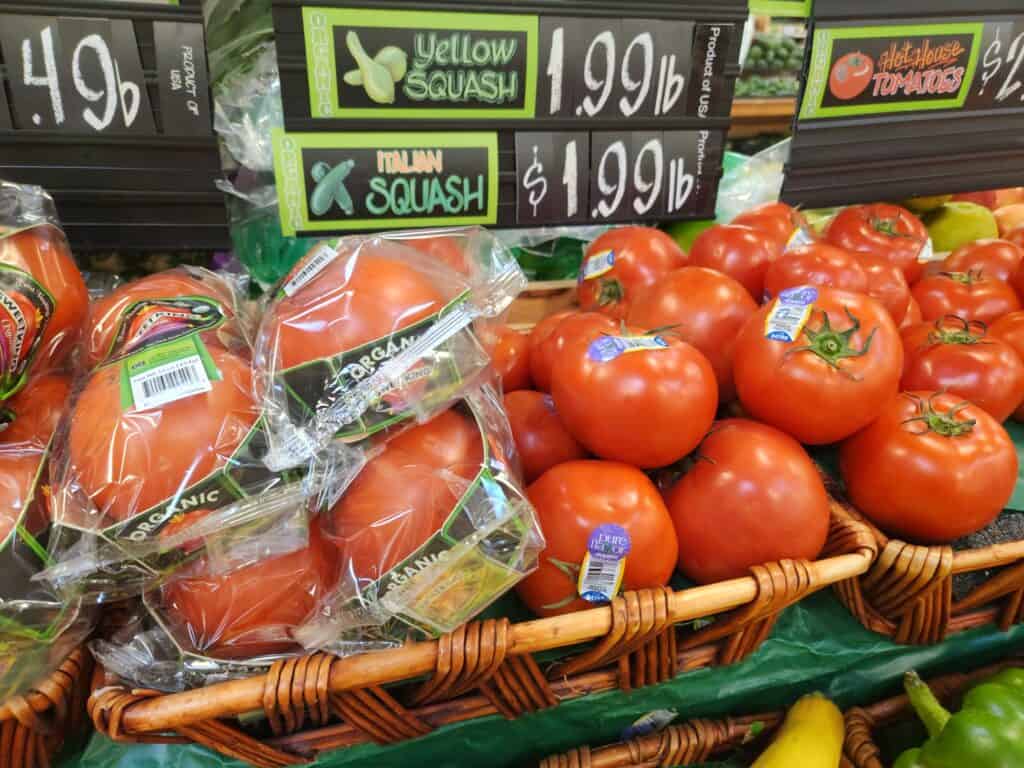
Reducing your plastic footprint while at the grocery store
Reducing plastic and other waste in the kitchen starts with making eco-conscious shopping decisions.
Whenever possible, choose products with plastic-free packaging. If you can’t find plastic-free, look for products with the least amount of plastic packaging. For products that you use regularly, you may want to opt for larger packages over single-serve convenience packs that tend to create a lot more waste.
Some stores have bulk sections where nuts, spices, grains, other dry goods, and household products can be purchased in reusable bags and containers from home—no packaging necessary! Use the Litterless Zero Waste Grocery Guide to find the closest stores that offer ways to buy waste-free.
Don’t forget your reusable shopping bags!
One of the most effective ways to reduce plastic waste from your shopping trips is to be ready with reusable grocery and produce bags to bring the things you buy home. This one super eco-friendly shopping habit alone can significantly reduce your plastic footprint!
2. Avoid using single-use plastic products like cups, plates, utensils, and straws as much as possible
It can be easy to get into the habit of using single-use dinnerware and other disposables without considering their impact on the environment. These short-lived products use up resources, contribute to pollution, and create a lot of waste!
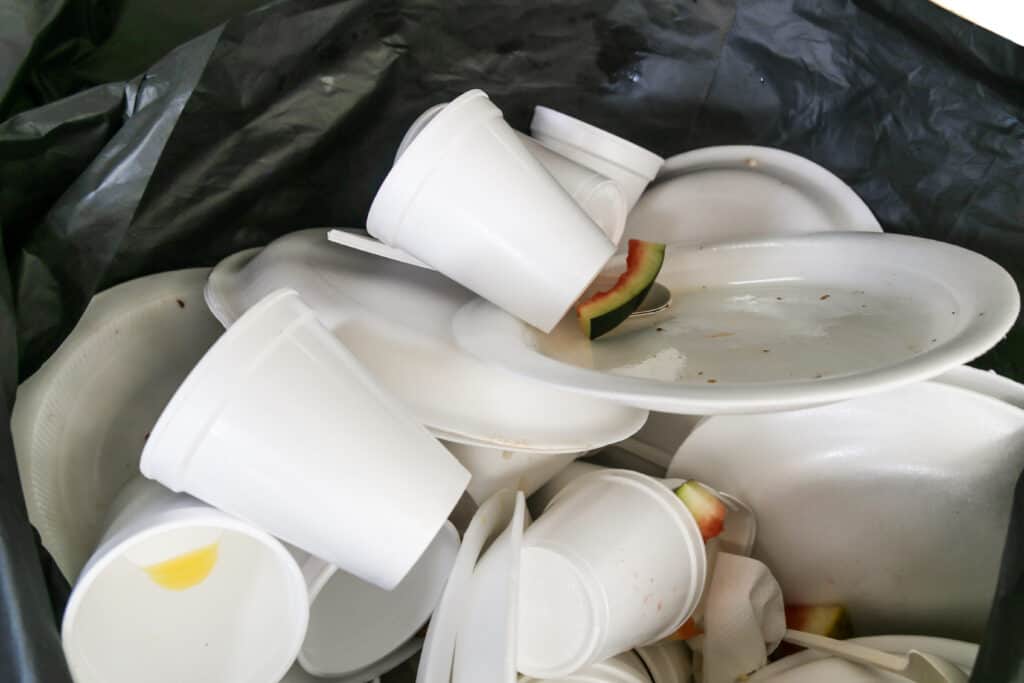
But the truth is, most disposable tableware can be avoided while eating at home. All it takes is a simple and eco-conscious choice to use regular dishes and utensils that can be washed and used again. Not to mention, continually buying single-use cups, plates, and utensils can become costly over time. So, opting for reusable versions can also help you save money!
3. Replace disposable plastic food wrap and storage bags with reusable options
Buying box after box of disposable food storage bags and rolls of plastic wrap leads to a lot of unnecessary waste – and it also adds up for your wallet over time! The good news is that these types of single-use plastic products can often be easily avoided with a few plastic-free swaps and changes to your kitchen routine.
It starts with using what you already have at home…
Sometimes, all it takes to avoid disposable plastics is using something you already have at home. A simple reusable container and lid can often replace single-use plastic wraps and bags. Upside-down plates and bowls can also make great temporary covers for a meal waiting to be eaten.
Eco-tip: Finding new uses for things we already have—instead of buying more new items—helps reduce our footprint.
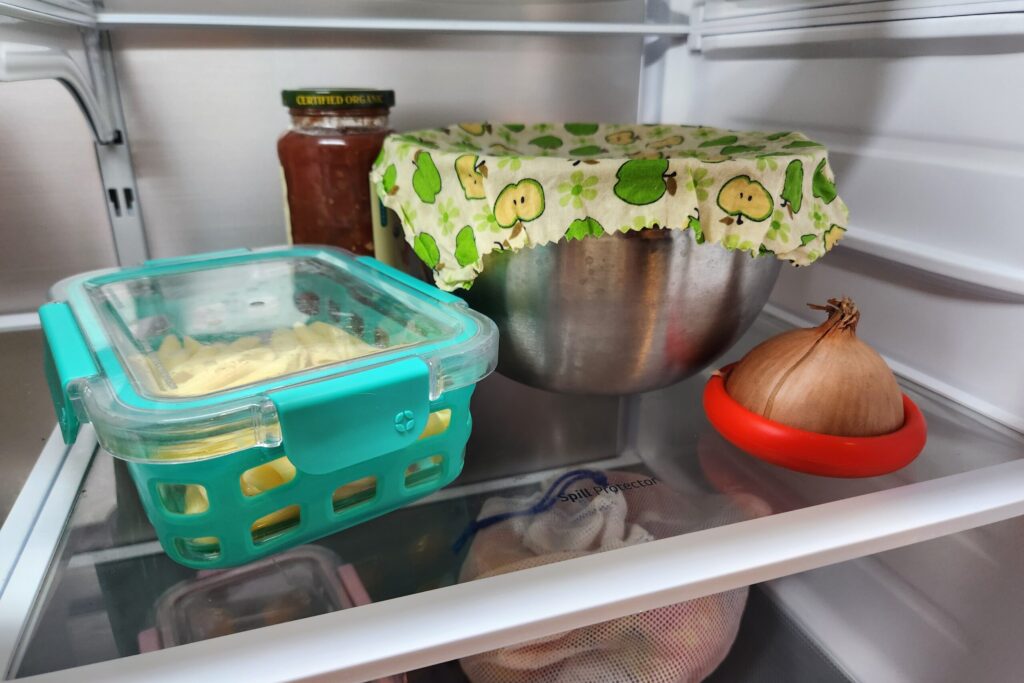
Swaps for plastic cling wrap
When it comes to wrapping and storing food, there are many great reusable options to choose from that don’t involve disposable plastic. These include:
- Wax wraps (Pictured above) *Note: Cannot be used in the oven/microwave or on hot dishes
- Silicone food savers or “huggers”
- Silicone bowl covers
- Fabric bowl covers
Reusable food storage bags
Skip the single-use food storage bags and replace them with durable versions made of silicone or other materials. These washable, resealable bags are great for packing lunches and bringing snacks on the go. And since they’re reusable, they don’t end up in the garbage can!
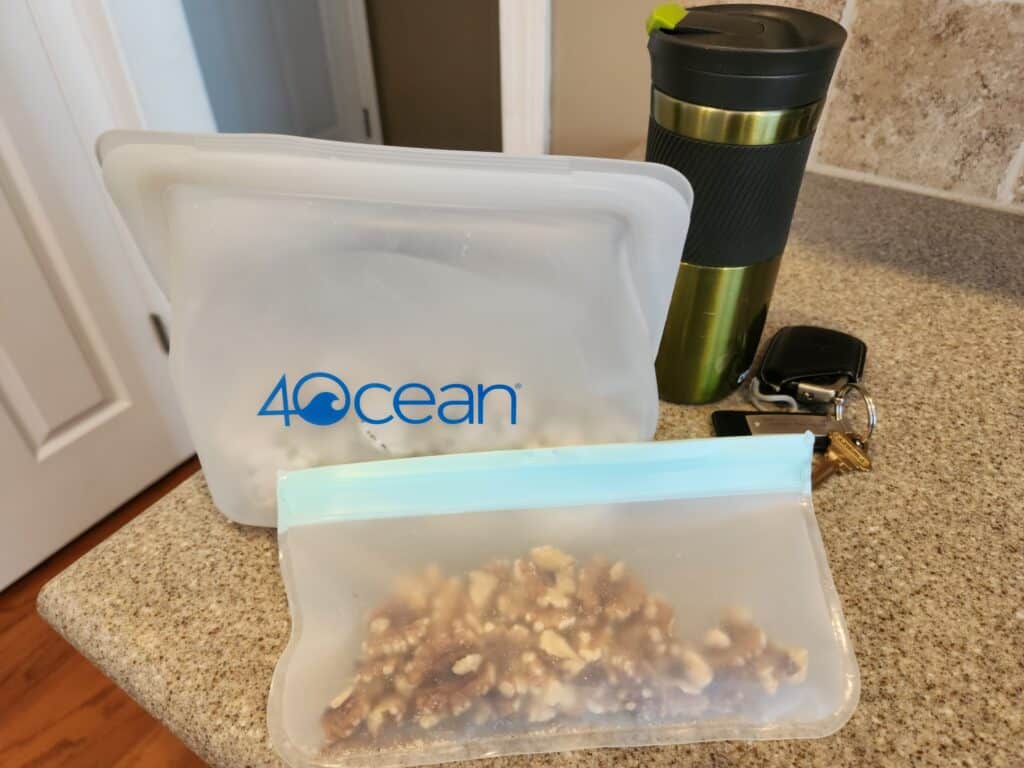
4. Switch to plastic-free dishwashing supplies
If you walk down the dishwashing supply aisle at a typical grocery store, you’ll probably see shelf after shelf filled with plastic dish soap bottles and thick plastic tubs containing plastic-wrapped dishwasher tablets. You’ll also likely find lots of plastic brushes, scrubbers, and colorful sponges wrapped in—yes—more plastic.
But here’s the thing: Washing dishes doesn’t need to involve so much plastic!
If you’re willing to step outside of your regular shopping routine, you’ll discover a wide range of dishwashing supplies that are much kinder to our planet. Here are just a few listed below:
Earth-friendly dishwashing supplies
- Sponges, cloths, scrubbers, and brushes made from plant-based, compostable materials*
- Solid dish soap bars and blocks packaged in recyclable boxes
- Dish soap concentrates & powders packaged in plastic-free containers that can be refilled, composted, or recycled
- Earth-friendly dishwasher tabs and pods that don’t come with plastic wrappers or bulky containers
*If you’re not already composting and want to learn more, check out our All About Composting: Videos & Resources page.
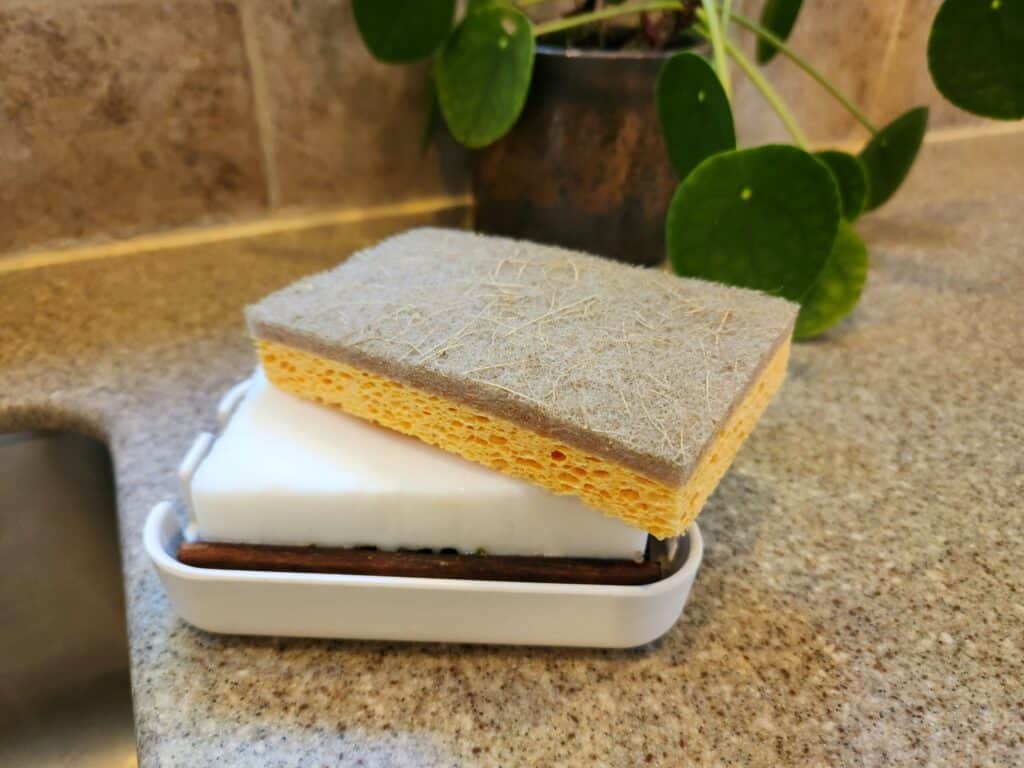
Where to find eco-friendly kitchen supplies
Zero-waste stores are popping up all around the world, especially in larger cities. These ultra-eco-friendly shops only sell products with the highest Earth-friendly standards when it comes to packaging and contents. But if you don’t happen to have a zero-waste store nearby, grocery stores specializing in natural and organic foods will also often carry a selection of eco-friendly household products. Use the Litterless Zero Waste Grocery Guide to check for local stores that may carry plastic-free and zero-waste household products.
If buying locally is not an option, a quick online search for a specific zero-waste or eco-friendly product will lead you to many great options!
Eco-Tip: When ordering eco-friendly products online, look for companies that offer plastic-free shipping. After all, one of the main goals is to reduce the amount of plastic waste you create!
5. Swap out single-use hand soap dispensers
Using single-use pump hand soap dispensers for the kitchen sink creates a lot of wasted plastic over time. Not to mention, continually buying and replacing pump soaps can be costly! Even though these plastic containers are sometimes recycled, their pump tops typically aren’t recyclable. So, they’ll usually just end up in the landfill or incinerator.
But thankfully, we have lots of great eco-friendly alternatives to choose from in the hand-washing department! Here are a few below:
Plastic-free hand soap options
Hand soap concentrates
One way to avoid using single-use pump containers is to buy hand soap concentrates in compostable or recyclable packaging. These concentrates are available in many different forms, including tablets, bars, and even water-soluble pods. Most of them just need water and take only a few minutes to make—then you can fill up a reusable soap dispenser!
Make your own foaming hand soap
Making your own foaming hand soap at home is easy—all you need is castile soap, water, and a foaming soap dispenser. Combine one part pure castile soap (like Dr. Bronner’s brand) with three to four parts water in a foaming soap dispenser, and you’re done—instant foaming hand soap! *Note: The ratio of castile soap to water can be adjusted based on your preferred consistency.
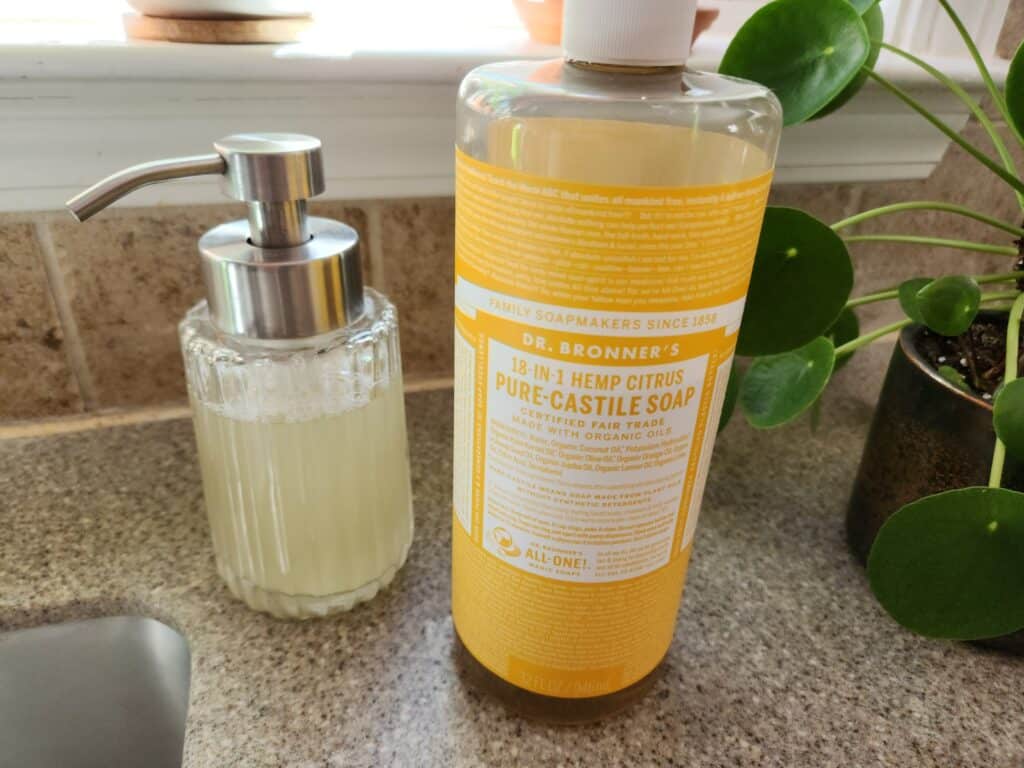
Since one bottle of ultra-concentrated castile soap can last a long time, making hand soap this way helps reduce the number of single-use containers and pump tops that go to waste.
Eco-Tip: To shrink your footprint even more, reuse an empty foaming soap dispenser that originally came full from the store.
Hand soap refills
Some zero-waste stores have refill stations where customers can fill up their own containers—no packaging necessary! Use the Litterless Zero Waste Grocery Guide to discover if your area has refill options.
Bar soaps
Bar soaps can be another Earth-friendly option, especially if they come wrapped in paper or don’t have packaging at all!
One final note…
Trying to make too many changes all at once can seem overwhelming. If you’re taking steps to reduce your footprint, it can be helpful to focus on one or two areas first and take time to get used to new products and routines before moving on. Each of our small steps adds up to make a big difference!
Related posts:
Skip single-use on the go: Bring these reusables along with you!
The quick start guide to Going Greener: Shrink your footprint today!
Explore and Learn more:
Our planet is choking on plastic | UN Environment Programme
Single-Use Plastics 101 | NRDC

